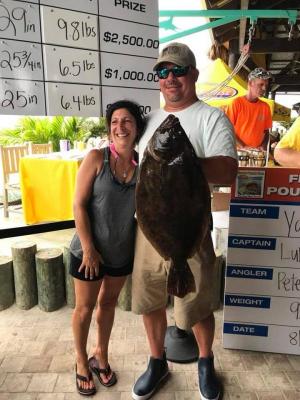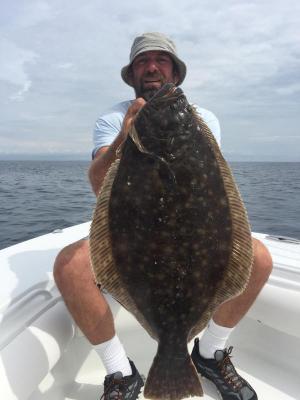The Flounder Pounder Open Tournament was held out of Paradise Cove, sponsored by Short’s Marine, with anglers allowed to fish any three days from Aug. 19 to Aug. 23. There were more than 300 boats entered, with a top prize of $100,000.
Team Stalker held the lead for several days with an 8.5-pound flounder until Team Yahoos took over with a 9.8-pound flounder on Saturday. That held up through Sunday, and Team Yahoos took home the big check. Second place and $50,000 went to Team Stalker, while Team Sea Hawg won third and $25,000 for its 8.4-pounder. Fourth place went to team El Nino with an 8.1-pound flounder, while Team Fish Bones came in fifth with a 7.9-pounder.
In addition to these prizes, there was a daily Calcutta worth $2,500 for the largest flounder of the day. The second largest won $1,000 and third largest took home $500.
This is the richest flounder tournament in the world, and I am sure it is going to attract more and more boats and anglers as it progresses. Right now, small boat owners can fish this tournament and have a chance for a really big prize. My fear is with that much money on the line, some of the larger boats with unlimited range can enter and run as far as needed to find a big flounder. I hope the tournament officials will decide to put a limit on the distance a boat can travel from Indian River Inlet and keep this a local tournament.
Fish pots on artificial reefs
The Delaware Artificial Reef Program is the best of any state on the East Coast and certainly one of the best in the world. We have Jeff Tinsman to thank for much of this and also for applying to the Mid-Atlantic Fishery Management Council and being successful in getting our reefs in the federal waters of the Atlantic Ocean put out of bounds for commercial fishing other than hook and line.
Recently I have seen posts on social media wondering why there are sea bass pots on some of our artificial reefs. As social media often does, there were comments from people who have no idea what they are talking about, and just in case you may have read these or want to know the correct answer, please let me explain.
The state of Delaware is required by management plans to survey the populations of various species found in state waters or waters off our coast in the federal Exclusive Economic Zone, also known as the EEZ. The state conducts trawl surveys to find and count most of these fish, but anyone who knows anything about black sea bass or tog knows they stick to structure like glue. Trawls don’t work real well over hard structure, such as is found at reef sites, so the only reasonable way to count them is to trap them in pots.
To this end, the state contracts commercial fishermen who have experience setting pots to do so with DNREC employees on board to observe, tag and count the fish. The day the state sank the Twin Capes, John Clark was onboard Chet Townsend’s boat doing just that.
Scott Newlin is the project leader for this survey, and he was kind enough to explain how it works. They will sample eight reef sites: 5, 6, 7, and 8 in the bay and 9, 10, 11 and 13 in the ocean. Twenty pots are set on each site with 10 pots set in two different locations.
So far the primary catch in the bay has been spider crabs. Many, many, many spider crabs, according to Scott. In the ocean, they are seeing croaker, flounder and tog at Site 9, and sea bass and tog at sites 10, 11 and 13. They are already seeing some of their tags returned, so the survival of the released fish has been good.
The study will run until the end of the year and then the data will be analyzed. They hope to keep it running along with the trawl and other surveys.
Fishing report
A lot of flounder were caught during the Flounder Pounder Open, and I suspect there will be some good action in the ocean and bay once the seas settle down. It looks like the weekend should be fishable, so I hope lots of folks will be out on the water.
Croaker have been taken out of the bay, with good catches reported from Site 8 to the pier at Woodland Beach. They have also been caught from the Lewes-Rehoboth Canal, the Broadkill River and just outside the Indian River Inlet. You can’t beat bloodworms when it comes to catching croaker.

























































